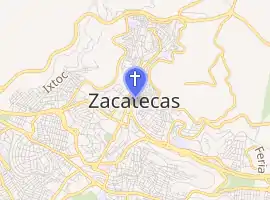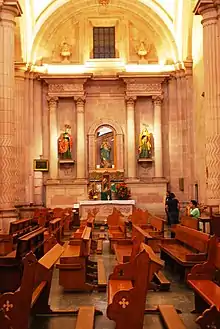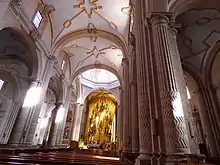Cathedral Basilica of Zacatecas
The Cathedral Basilica of Zacatecas (Cathedral of Our Lady of the Assumption of Zacatecas) is a Catholic church in Zacatecas City, Zacatecas, Mexico. It is the head temple of the Diocese of Zacatecas, and is dedicated to Our Lady of the Assumption. The cathedral is located in the historic city center, and was declared a World Heritage Site by Unesco. The main facade of the premises is known as one of the most outstanding examples of Baroque art in Mexico.
| Cathedral Basilica of Zacatecas | |
|---|---|
| Cathedral of Our Lady of the Assumption of Zacatecas | |
.JPG.webp) View of the Cathedral of Zacatecas | |

| |
| 22°46′32″N 102°34′20″W | |
| Location | Zacatecas City, Zacatecas |
| Country | Mexico |
| Denomination | Roman Catholic |
| History | |
| Dedication | Assumption of Mary |
| Architecture | |
| Style | Churrigueresque, Neoclassical |
| Groundbreaking | 1729 |
| Completed | 1772 |
| Specifications | |
| Number of spires | 2 |
| Administration | |
| Diocese | Zacatecas |
History
The current building was preceded by two temples. The first was built in the year 1568, as a parish church of the city, which was of small dimensions. A second temple was built in place of the old and was known to be consecrated in 1625.
In order to build a temple of larger size worthy of the city of "the aristocrats of silver", everything built was demolished, and the walls of the building we meet in our day rose. The first stone was laid by Don José de Izarraguirre, episcopal vicar. The work was dedicated in 1752 and consecrated in 1841, when the construction of the façade and the north tower was completed. This tower holds a clock donated by Governor Genaro García Rojas.
In 1862, Pope Pius IX gave the church cathedral status. And finally, in the year 1959, Pope John XXIII elevated it to a basilica.
The building
The floor of the building is shaped like a Latin cross. Three naves, the main and two sides, with less than the first. It has two side access covers, worked in stone and with no less detail than the first, the latter, the best finish and detail of Baroque art in the country. The original dome was replaced by the current, which bears a strong resemblance to the Templo de Loreto in Mexico City. It is octagonal, with lantern, surmounted by a wrought iron cross.
The building's exterior is covered with pink stone and are very worked both covers and towers, unlike the interior of sober neoclassical.
The main facade
| UNESCO World Heritage Site | |
|---|---|
 Baroque facade of the Cathedral of Zacatecas | |
| Criteria | Cultural: ii, iv |
| Reference | 676 |
| Inscription | 1993 (17th session) |
Elegant and decorated as a show of lace carved in stone. It consists of three bodies. The first three columns of Corinthian capital, with the stem highly ornamented with angels and plant motifs, mainly vines between each column are located in niches with pedestals that houses the stone carvings of the apostles St. James, St. Peter, St. Paul and St. Andrew. The entrance arch so mixtilineal, is also decorated with reliefs of diamonds, angels and floral motifs.
The second level houses the window of the choir, of Worth, mixtilineal finishing with moldings and framed by a ring excessively decorated with plant motifs, anthropomorphic and in high relief type key cup and in the corners of it, the four doctors of the Latin Church with their respective attributes, (St. Gregory the Great, St. Jerome, St. Augustine of Hippo and St. Ambrose of Milan, the first two in the top corners and the last two in the bottom corners). Three columns decorated with plants and vines guarding the window of the choir. Similarly in the second body between each column a niche with a pedestal, four in total, with sculptures of saints.
The third, smaller body has five niches flanked by Baroque pilasters, decorated by floral motifs, and holding five sculptures: Four apostles and the central niche is chaired by the sculpture of Jesus Christ.
The pediment of the façade, presents a picture of the glory to the Eternal Father, it could say the whole scene presides developed in the facade.
It is said that the color tones in the quarry of the facade gives change as sunlight during the day. So the best time to observe is between 14.30 and 18.00 hours.
The side covers
With two side doorways. The first, north, dedicated to Lord of the parish. It consists of two parts, the first arc of half point, its spandrels have vegetable ornaments and angels, has a copy in stone of a Christ who is inside. On either side figures of caryatids with plant motifs and cherubs. The second body, more elaborate than the first, a set framed by columns stipes with the image of Christ, the Virgin Mary and St. Joseph, with a curtain deployed by angels. Have a shot mixtilineal.
The cover South, dedicated to Our Lady of Zacatecas, whose sculpture is in a niche, this is mentioned to have been sculpted by an artist sentenced to death, he saved his sentence with this sculpture. The facade, with two bodies: the first with arch, flanked by baroque columns, decorated with plant motifs. The second section presents the above image, guarded by two caryatids columns.


The interior
The cathedral's interior bears an austere and functional appearance, which greatly contrasts with its richly decorated exterior. This can be seen with its large Doric columns and neoclassical side altars. On the keys of the arches, there are Marian symbols, figures of saints, evangelist, clergy and objects of passion.
The cathedral contains an altar designed by artist Javier Marín from Michoacan, which is gilded in 24-carat gold. It is 17 feet high and ten wide and covered with 25 kg of gold from Mazapil. It was constructed from geometric prisms born of the upper platform of the sanctuary and contains niches where elaborate images of saints are placed. It weighs about 20 tons and is made of Finnish birch, a very hard wood that neither expands or shrinks, as it does not react to changes in humidity. The altarpiece has eleven images. At the top is the Virgin of the Assumption, who is consecrated the temple. On both sides are the parents of the Virgin, Santa Ana and San Joaquin. In the lower part are San Juan Bautista, San Agustin, Santo Domingo, San Antonio de Padua and San Ignacio de Loyola. On the sides were placed images of the martyrs San Mateo Correa and Blessed Miguel Agustín Pro. The cross is made of bronze and measures 4.2 meters high and two meters wide.
See also
External links
| Wikimedia Commons has media related to Cathedral of the Assumption in Zacatecas. |
